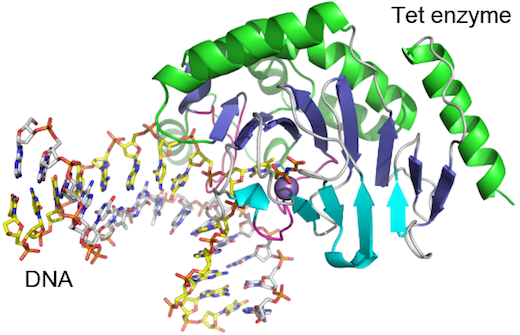Nature:埃默里大学解析Tet-样蛋白结构的表观遗传学之谜
科学家们已经获得Tet酶家族成员之一的详细分子结构。这一发现对表观遗传学领域是很重要的,因为Tet酶以化学方法更改DNA,改变标识告诉细胞机构“这一基因是关闭的”进入其他标识说“准备改变”。文章发表在近期的《Nature》杂志上。

Tet酶
仅在过去的五年中已经发现Tet酶的作用;它们是干细胞维持其多功能状态所必需的,并且与早期胚胎和脑发育以及癌症相关。这将有助于科学家理解Tet酶是如何调节和寻找药物操纵它们。
程晓冬博士采用x射线衍射晶体分析法确定阿米巴鞭毛体的Tet家族一个成员的结构。结构显示酶与其靶向DNA相互作用,弯曲了双螺旋并基础失控被修改。
Naegleria Tet-样蛋白(NgTet1)与哺乳动物Tet蛋白的序列相似性大约为39%,同时也具有相似的生化活性。与含有一个甲基化的CpG点的DNA形成复合物的NgTet1的晶体结构显示,NgTet1利用一个碱基翻转机制来接触5mC。
原文摘要:
Structure of a Naegleria Tet-like dioxygenase in complex with 5-methylcytosine DNA
Hideharu Hashimoto,June E. Pais,Xing Zhang,Lana Saleh,Zheng-Qing Fu,Nan Dai,Ivan R. Corrêa,Yu Zheng & Xiaodong Cheng
Cytosine residues in mammalian DNA occur in five forms: cytosine (C), 5-methylcytosine (5mC), 5-hydroxymethylcytosine (5hmC), 5-formylcytosine (5fC) and 5-carboxylcytosine (5caC). The ten-eleven translocation (Tet) dioxygenases convert 5mC to 5hmC, 5fC and 5caC in three consecutive, Fe(ii)- and α-ketoglutarate-dependent oxidation reactions1, 2, 3, 4. The Tet family of dioxygenases is widely distributed across the tree of life5, including in the heterolobosean amoeboflagellate Naegleria gruberi. The genome of Naegleria6 encodes homologues of mammalian DNA methyltransferase and Tet proteins7. Here we study biochemically and structurally one of the Naegleria Tet-like proteins (NgTet1), which shares significant sequence conservation (approximately 14% identity or 39% similarity) with mammalian Tet1. Like mammalian Tet proteins, NgTet1 acts on 5mC and generates 5hmC, 5fC and 5caC. The crystal structure of NgTet1 in complex with DNA containing a 5mCpG site revealed that NgTet1 uses a base-flipping mechanism to access 5mC. The DNA is contacted from the minor groove and bent towards the major groove. The flipped 5mC is positioned in the active-site pocket with planar stacking contacts, Watson–Crick polar hydrogen bonds and van der Waals interactions specific for 5mC. The sequence conservation between NgTet1 and mammalian Tet1, including residues involved in structural integrity and functional significance, suggests structural conservation across phyla.

